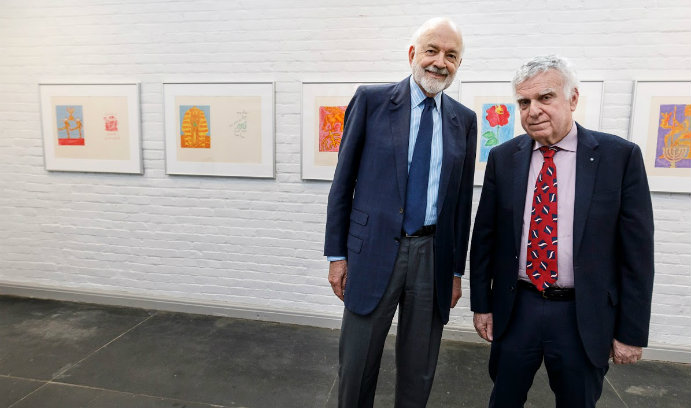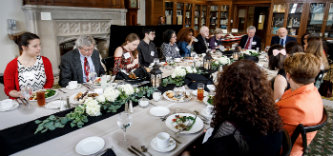Vivid Colors Capture Jewish History

Through the generosity of Amy and Joseph Perella ’64 ’06H (left), a set of prints of 'All This Has Come Upon Us,' which represents historical incidents of anti-Semitism, has become part of Lehigh’s permanent teaching collection. Five pieces of art from the portfolio were premiered in Williams Hall on April 27. Artist and physician Mark Podwal (right) has authored 13 books, many that focus on Jewish history, legend and tradition. The 42 original works were created by using colored pencil, acrylic and gouache.
In 1977, five years following the Munich Massacre in which 11 members of Israel’s Olympic team and one German police officer were killed, France managed to arrest one of the perpetrators, Abu Daoud, but soon released him out of apparent political concerns. Disillusioned, a young physician, Mark Podwal, depicted the event in one of his many drawings for The New York Times. That drawing initiated a collaborative friendship with Elie Wiesel, author, Nobel Laureate and Holocaust survivor, who contacted Podwal about his work. It was through Wiesel’s influence that Podwal began a life-long dedication to depicting anti-Semitism through art.
From this start, Podwal created a series of 42 works of art, All This Has Come Upon Us, the prints of which have been acquired by the world’s major museums and institutions of learning. Now, thanks to the generosity of alumnus and Lehigh Board of Trustee member Joseph R. Perella ’64 ’06H and his wife, Amy, a set of prints on historical incidents of anti-Semitism has become part of Lehigh’s permanent teaching collection. Five of the pieces are now on display in Williams Hall, a facility dedicated to providing opportunities for cultural understanding and global awareness. The remaining prints will be rotated through the exhibit, to enhance the student and Lehigh community experience.
Each print recounts one or more instances of heinous treatment, such as the pogroms or Crusades, or the fact that, at one time, a third of the Jewish population of the Ukraine and Poland was destroyed. The artwork shows the deep history of the Jews, one of the most persecuted people in the history of the world.
During the exhibit opening on April 27, Podwal spoke about his work to a full house in the Herbert A. Roemmele ’53 Global Commons. He mentioned that the presentation of the prints to Lehigh was more meaningful than any of the other presentations about his work that he has attended. He explained that Lehigh brought something else into the mix, an ingredient more potent than the brightest paint and one that inspires more hope than any image could: The university provided a roomful of interested students.
In addition to Lehigh’s collection, Podwal’s art resides in the Vatican, the Metropolitan Museum in Manhattan, the Victoria and Albert Museum in London, the Library of Congress, the U.S. Holocaust Museum, the Bavarian State Library, and Harvard, Yale, and Columbia universities.
“We are proud to have the Podwal Portfolio find a home at Lehigh,” said Patrick V. Farrell, provost and vice president for academic affairs, who gave opening remarks at the exhibit. Farrell also expressed appreciation for Perella’s support of Lehigh’s efforts to teach inclusion at all levels and to celebrate diversity.
The exhibit opening included a review of Podwal’s artwork by Marc Epstein, professor of religion on the Mattie M. Paschall Davis and Norman H. Davis Chair, Vassar College. Introductions and remarks were given by Hartley Lachter, Philip and Muriel Berman Chair in Jewish Studies and director of the Berman Center for Jewish Studies, who also moderated a discussion between Podwal and Epstein.
Seeking to Understand Through Art
The audience was quick to see the need for the exhibit.
Toni Isreal ’17 said, “It’s very important to offer programs like this, because memory is short, and we have to have constant reminders of the evils of history, so we don’t repeat the mistakes.”
Alumnus Herb Ford ’68 and wife, Caren, traveled almost 80 miles to Lehigh for the Podwal exhibit and presentation, because it was art, and because it was Jewish-themed. “There was no Jewish studies program when I was here,” said Ford.
At the reception, Ford pointed out the vast array of choices that his children and grandchildren have today. It’s not a stretch to surmise that this is thanks to the ever-expanding understanding and value placed on learning about others and being moved out of indifference to the suffering of others.
Perella, who is known as “the gentleman of Wall Street” in the finance world, has supported projects that move cultural understanding forward. He was executive producer of the documentary My Italian Secret: The Forgotten Heroes. The film, which he brought to Lehigh in 2015, depicts how many Italians took great risks and protected Jews during the Holocaust. As a result, 80 percent of the Jewish population in Italy survived.
A History Rarely Glimpsed in a Single Body of Work
Podwal is described as a master of two disciplines. He is a practicing physician in New York City and hailed as one of the greatest Jewish artists today. He has a particular way of looking at the world, and his work takes viewers into the heart of it.
Podwal’s wife, Ayalah, shared her happiness that he transitioned from working only in black and white to bright colors to depict a subject that has rarely, if ever, been documented in a single body of work.
Podwal expanded his canvas from showing the horrors of the Terezin concentration camp to including anti-Semitism through the ages. He also chose to juxtapose each scene against a quote from the Book of Psalms, like the facing pages of a single open book. One of the prints depicts a sword running through Jerusalem from below; across from it, the psalm begins in Hebrew, “Why did the heavens not darken?”
In his review of Podwal’s work, Epstein pointed out themes such as the serpent of treachery (one is shown in place of Pharaoh’s lips: “His mouth is full of curses, deceit and oppression; on the tip of his tongue are mischief and evil.” Psalm 10:7). Then there is the Torah. In one work, the Torah scroll is replaced with or surrounded by a human rib cage.
Epstein noted that hopeful images appear toward the end of the series. “Faith” and “Praise,” for example, or “A Song,” in which a menorah stands on its own holding the seven fruits of the land of Israel juxtaposed with the flag of Israel (“Those who plant in tears will harvest in joy.” Psalm 126:5).
During the exhibit, Perella explained why Podwal’s work is so important and what deeper purpose prompted him to bring the prints to Lehigh. It helps us, Perella said, fulfill what he called the ‘11th Commandment’: “Thou shalt not remain indifferent.”
Story by Jennifer Lader
Photos by John Kish IV
Click here to view more photos from the event.
Posted on:






